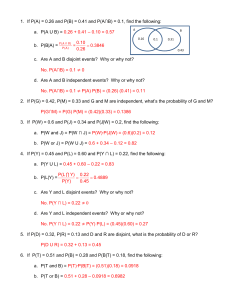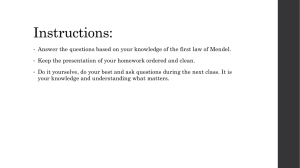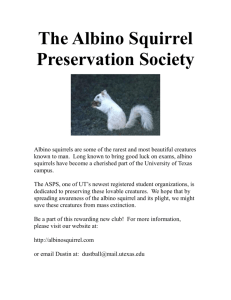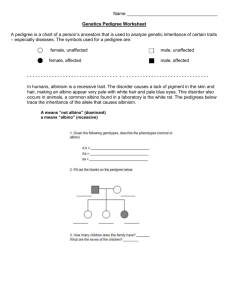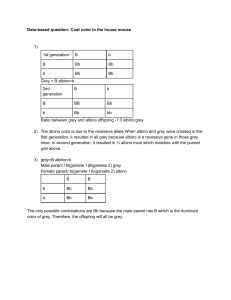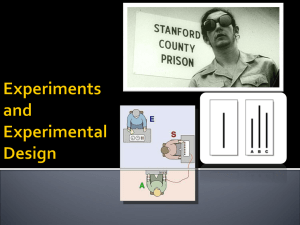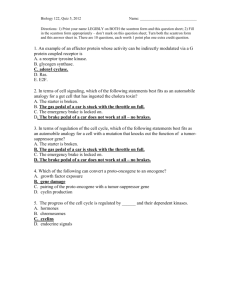Probability Rules Worksheet: Practice Problems & Solutions
advertisement
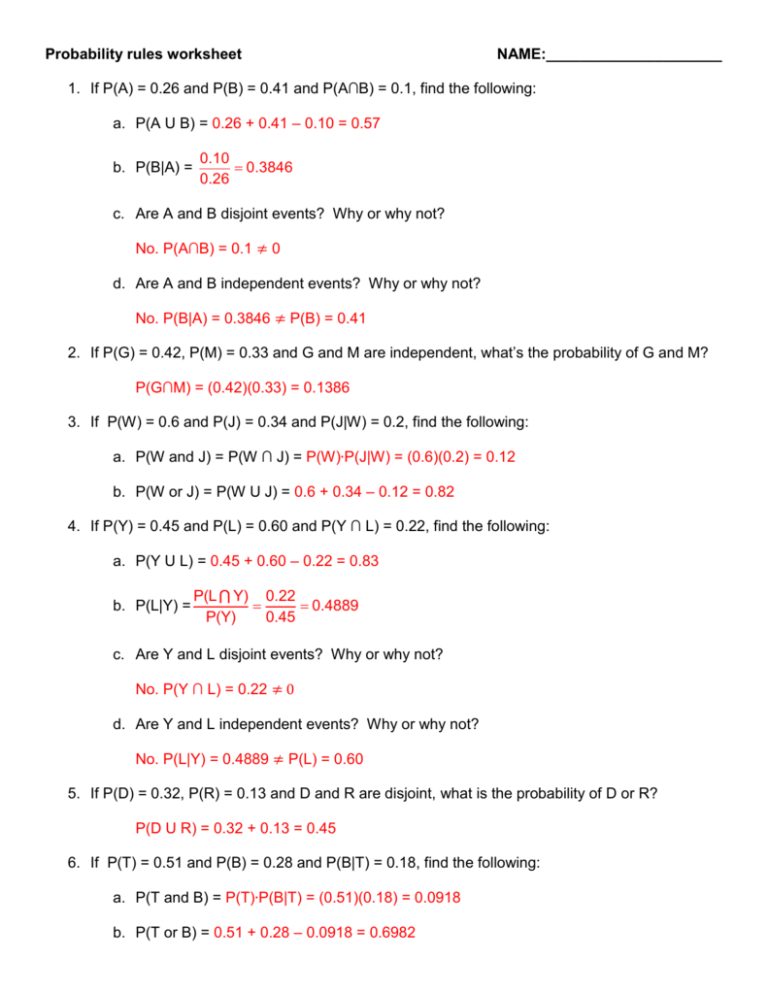
Probability rules worksheet NAME:_____________________ 1. If P(A) = 0.26 and P(B) = 0.41 and P(A∩B) = 0.1, find the following: a. P(A U B) = 0.26 + 0.41 – 0.10 = 0.57 b. P(B|A) = 0.10 0.3846 0.26 c. Are A and B disjoint events? Why or why not? No. P(A∩B) = 0.1 ≠ 0 d. Are A and B independent events? Why or why not? No. P(B|A) = 0.3846 ≠ P(B) = 0.41 2. If P(G) = 0.42, P(M) = 0.33 and G and M are independent, what’s the probability of G and M? P(G∩M) = (0.42)(0.33) = 0.1386 3. If P(W) = 0.6 and P(J) = 0.34 and P(J|W) = 0.2, find the following: a. P(W and J) = P(W ∩ J) = P(W)∙P(J|W) = (0.6)(0.2) = 0.12 b. P(W or J) = P(W U J) = 0.6 + 0.34 – 0.12 = 0.82 4. If P(Y) = 0.45 and P(L) = 0.60 and P(Y ∩ L) = 0.22, find the following: a. P(Y U L) = 0.45 + 0.60 – 0.22 = 0.83 b. P(L|Y) = P(L Y) 0.22 0.4889 P(Y) 0.45 c. Are Y and L disjoint events? Why or why not? No. P(Y ∩ L) = 0.22 ≠ 0 d. Are Y and L independent events? Why or why not? No. P(L|Y) = 0.4889 ≠ P(L) = 0.60 5. If P(D) = 0.32, P(R) = 0.13 and D and R are disjoint, what is the probability of D or R? P(D U R) = 0.32 + 0.13 = 0.45 6. If P(T) = 0.51 and P(B) = 0.28 and P(B|T) = 0.18, find the following: a. P(T and B) = P(T)∙P(B|T) = (0.51)(0.18) = 0.0918 b. P(T or B) = 0.51 + 0.28 – 0.0918 = 0.6982 7. Suppose in a lab 24% of the mice are albino, 56% are brown, and the rest are grey. a. What is the probability that a randomly selected mouse is: i. Grey P(G) = 0.20 ii. Not albino P(AC) = 0.76 iii. Grey or Albino P(G U A) = 0.44 b. If the type of mouse is independent of the next what is the probability that: i. 2 randomly selected mice are both brown? P(B ∩ B) = (0.56)(0.56) = 0.3136 ii. 2 randomly selected mice are albino then brown? P(A ∩ B) = (0.24)(0.56) = 0.1344 iii. 2 randomly selected mice are albino and grey? P(A ∩ G) = (0.24)(0.20)*2 = 0.096 iv. 2 randomly selected mice are not grey? P(GC ∩ GC) = (0.80)(0.80) = 0.64 v. At least 1 out of 4 randomly selected mice is albino? P(at least 1 A out of 4) = 1 – P(AC ∩ AC ∩ AC ∩ AC) = 1 – (0.76)4 = 0.6664 vi. The first albino mouse is the 5th one selected? P(AC ∩ AC ∩ AC ∩ AC ∩ A) = (0.76)4(0.24) = 0.0801 8. In the parking lot of the a large mall 64% of cars are foreign made, 12% are the color blue and 7.7% are blue and foreign made cars. B F a. Draw a Venn Diagram .563 .077 .043 .317 b. What is the probability that a randomly selected car was: i. A foreign car or a blue car? P(F U B) = 0.683 ii. Not a foreign car and a blue car? P(FC ∩ B) = .043 iii. A foreign car given it was blue? P(F|B) = 0.077 0.6427 0.12 iv. Not blue given it was not a foreign car? P(BC|FC) = 0.317 0.8806 0.36 c. Is being a foreign car and being blue mutually exclusive? independent? Not Mutually Exclusive because P(F ∩ B) = 0.077 ≠ 0 Independent because P(F|B) = P(F) 0.6427 = 0.64 9. The following table shows the breakdown of sex and degree among a university’s faculty. What is the probability that a randomly selected professor is a. Male and has a Doctorate P(M ∩ D) = b. Male or has a Doctorate P(M U D) = c. 28 0.70 40 A female with a Masters degree P(M|F) = e. 58 0.8788 66 Is a Male given they have a Doctorate P(M|D) = d. 28 0.4242 66 8 0.40 20 Is sex and degree independent? Disjoint? Independent: Yes. P(M|D) = 0.70 = P(M) = 0.6970 Disjoint: No. P(M ∩ D) = 0.4242 ≠ 0
